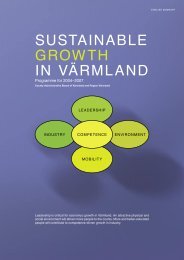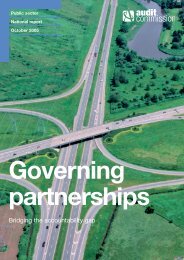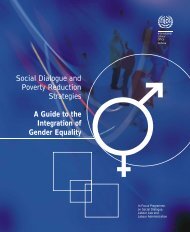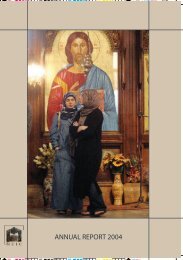PDF (222 KB) - Document Database website
PDF (222 KB) - Document Database website
PDF (222 KB) - Document Database website
You also want an ePaper? Increase the reach of your titles
YUMPU automatically turns print PDFs into web optimized ePapers that Google loves.
ACHIEVING THE LISBON GOALS<br />
THE CONTRIBUTION OF VOCATIONAL EDUCATION AND TRAINING IN ROMANIA<br />
<br />
model, focused on skill acquisition and<br />
European Credit Transfer System’s<br />
implementation, upholds modern<br />
teaching and learning methodologies, is<br />
student-centred and gives more<br />
attention to individualised teaching and<br />
the duration of instruction, with a view to<br />
facilitating the transition to the labour<br />
market and promoting an<br />
entrepreneurial spirit, critical thinking,<br />
communication and team-work abilities.<br />
Implementation of transferable<br />
credits along the vocational training<br />
route. Each skills unit has been<br />
assigned a number of credits to ensure<br />
the flexibility of the education system<br />
and the organisation of individual<br />
training routes.<br />
2.2 IMPROVING THE<br />
INTEGRATION OF DIFFERENT<br />
LEARNING SITES –<br />
INTEGRATION OF FORMAL<br />
AND INFORMAL LEARNING<br />
Links between VET schools and<br />
enterprises insufficiently developed to<br />
take a central place in the VET reform<br />
process<br />
The new curricula for the vocational and<br />
technical training and education include a<br />
large amount of time allocated to practical<br />
training (on average 43% of the curriculum,<br />
of which 10% is in-company training), with<br />
load differences between the two<br />
vocational routes, i.e., Arts and Trades<br />
Schools and technological high schools.<br />
However, as described above, most of the<br />
practical training takes place in schools,<br />
despite the fact that the new curriculum<br />
offers students the opportunity to gain<br />
practical experience in their chosen area<br />
through periods spent in the workplace, as<br />
well as the development of hands-on<br />
learning activities through projects, as part<br />
of the formal school framework.<br />
The Romanian IVET system suffers from a<br />
lack of connection between school learning<br />
and enterprise training. At present,<br />
systematic contacts between schools and<br />
enterprises, at least for some training<br />
profiles and especially in rural areas, are<br />
non-existent. Practical placements in<br />
enterprises are often performed in groups<br />
of students under the supervision of an<br />
instructor teacher, and therefore fail to<br />
represent a real insertion into the world of<br />
work. The increasing number of small<br />
companies makes it more difficult to find<br />
practical placements for students. In the<br />
tourism and public administration field,<br />
practical training includes a system of<br />
training firms that simulate the practical<br />
activities of larger companies.<br />
Given these difficulties, a major goal of the<br />
current TVET reform is the alignment of<br />
educational provision in schools with labour<br />
market needs; similarly, at local level, there<br />
is a need for an improved relationship<br />
between VET schools and employers. With<br />
these goals in view, strengthening the<br />
partnership and the collaboration between<br />
schools and economic partners has been<br />
declared a priority of the Regional<br />
Education Action Plans. The schools<br />
included in the Phare RO TVET 0108.2001<br />
programme have established partnerships<br />
with local economic agents, based on<br />
institutional agreements, in order to ensure<br />
access to up-to-date equipment and<br />
improved facilities for work insertion. The<br />
partnerships also envisage an improved<br />
labour market information system, and<br />
counselling and career-orientation<br />
services. In spite of these examples of<br />
good practice, practical training in<br />
enterprises needs to be reinforced in terms<br />
of its contents, duration, forms and<br />
numbers of practising students, and thus<br />
become a significant means of facilitating<br />
the transition from school to the workplace.<br />
Accreditation of prior learning is<br />
developing, practices exist and a law is<br />
in preparation<br />
With respect to the integration of formal<br />
learning with non-formal learning, the<br />
model devised to extend the period of<br />
compulsory education to 10 years<br />
envisages the introduction of learning<br />
standards common to all students. Based<br />
on common standards, both learning<br />
assessment and end-of-cycle testing are to<br />
be introduced. The testing is to be<br />
organised at local level based on national<br />
standards, and lifelong learning portfolios<br />
will be taken into account. The portfolios<br />
18








